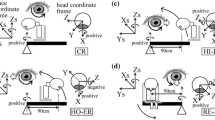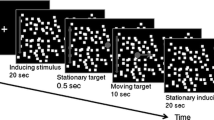Abstract
Eccentric sinusoidal rotation with the nose facing out or in leads to gain modulation of the vestibulo-ocular reflex (VOR), which is a result of an interaction between angular and translational VOR. There are conflicting reports with regard to the type of interaction. Combined angular and translational VOR during eccentric sinusoidal rotations over a wide range of target distances (12–180 cm), eccentricities (centric, 30 and 50 cm nose-out and nose-in eccentric) and frequencies (0.1–4 Hz) were studied in macaque monkeys trained to fixate earth-stationary light-emitting diode (LED) targets while binocular eye positions were measured using magnetic search coils. The monkeys were also exposed to sudden unpredictable position steps with peak accelerations of 500°/s2 using similar eccentricities and target distances. VOR gain enhancement during nose-out eccentric sinusoidal rotation was almost compensatory when the target was visible and was independent of stimulus frequency. Mean responses were still close to ideal when the target was extinguished; however, individual data showed increased variability. Sensitivities of the translational portion of the combined VOR were compensatory. These sensitivities were clearly reduced during nose-in eccentric sinusoidal rotation. Thus, especially for close targets at 4 Hz combined VOR was not compensatory, independent of target visibility. VOR elicited by sudden position steps showed a sequential response: (1) purely angular VOR (up to 40–45 ms); (2) additional translational VOR that was not modulated by target distance (45–65 ms); and (3) translational VOR weighted for target location (>65 ms). We conclude that angular and translational VOR have different latencies during transient accelerations and interact differently during agonistic (nose-out) and antagonistic stimulation (nose-in).
Similar content being viewed by others
Author information
Authors and Affiliations
Corresponding author
Rights and permissions
About this article
Cite this article
Fuhry, L., Nedvidek, J., Haburcakova, C. et al. Non-linear interaction of angular and translational vestibulo-ocular reflex during eccentric rotation in the monkey. Exp Brain Res 143, 303–317 (2002). https://doi.org/10.1007/s00221-001-0986-4
Received:
Accepted:
Published:
Issue Date:
DOI: https://doi.org/10.1007/s00221-001-0986-4




